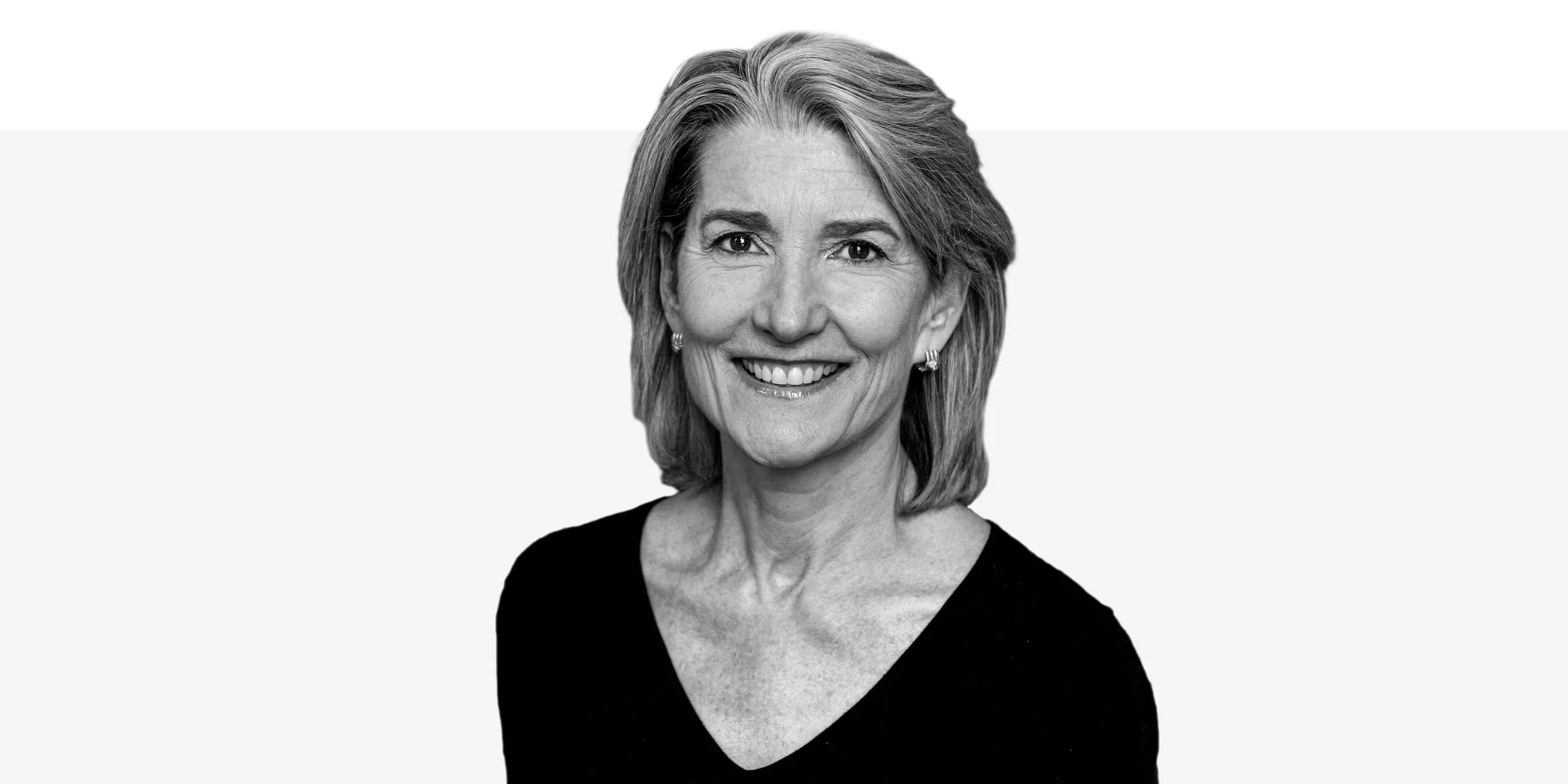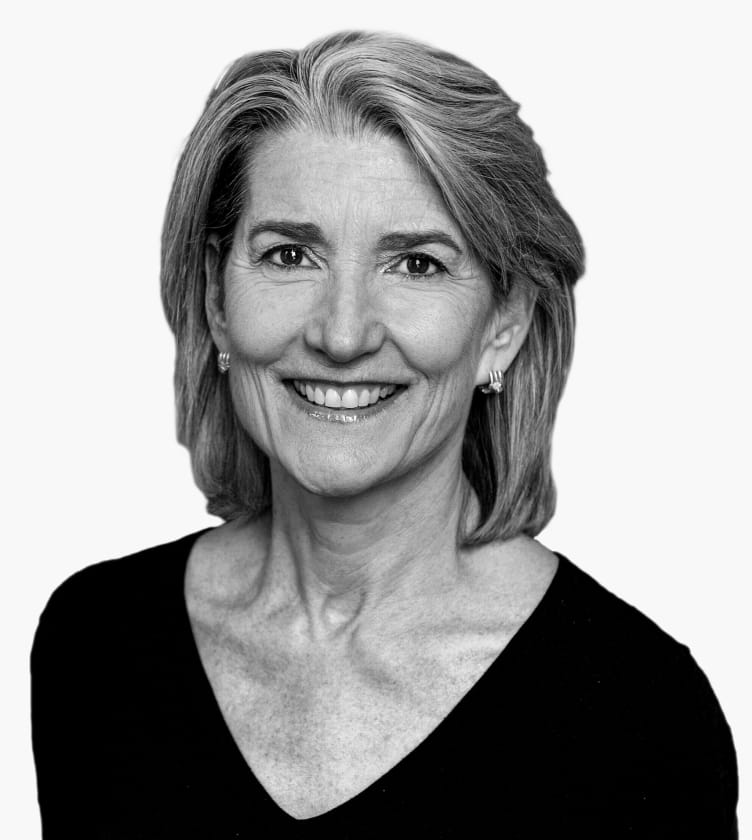Harvard Business School’s Amy Edmondson says ensuring a safe workplace, and one that rises above the chaos of the world will require transparency and fierce communication.
Amy Edmondson, the Novartis Professor of Leadership and Management at the Harvard Business School and author of the book The Fearless Organization, discusses the steps leaders should be thinking about as companies look to bring their employees back to the office.
On the episode, she touches on workspace safety, her concept of “psychological safety,” and transformative takeaways from her early years working for the forward-thinking 20th-century designer and engineer R. Buckminster Fuller, best known as the inventor of the geodesic dome.
Read more about the kind of empowerment and open, honest dialogue Edmondson’s says leaders can foster in their workplaces here.
SPENCER BAILEY: Hi, Amy. Welcome to the Workspace Of Tomorrow. It’s a pleasure to be with you today.
AMY EDMONDSON: Thanks for having me.
SB: I wanted to begin on the subject of “psychological safety,” which obviously is the core of your work, but also because it’s such a core component right now in terms of maintaining company morale in the midst of this pandemic, and also in terms of getting back to the office. Could you run me through a little bit about what exactly psychological safety entails?
AE: It’s the belief that speaking up is expected and welcomed, and that sounds like a very small thing, but it’s not to be taken for granted. There’s a very powerful human instinct to self-protect. And so, when in doubt we hold back, and a big, important thing to recognize nowadays is that when people are holding back, you’re not getting the ideas, you’re not getting the concerns, you’re not getting the questions, and performance will suffer.
SB: You’ve written about these four core areas around which psychological safety can be created, and that’s attitude to risk and failure, open conversation, willingness to help, inclusivity and diversity. We’re obviously in very challenging, difficult times right now. How can leaders establish these things across their organizations during this moment?
AE: Well, I think leaders can do three simple things, but simple doesn’t mean easy. And the first one is: Set the stage, frame the situation in ways that make it crystal clear that they genuinely want to hear from people, that they genuinely welcome those ideas, that they genuinely welcome the bad news, the crazy ideas, the tough question. Because they recognize that we collectively are more at risk if we’re not hearing from each other, if we’re not engaging in the tough conversations.
And the second thing to make that even easier is to just be perpetually asking good questions. To me, the essence of a good question is one that A) you don’t know the answer to, and B) that focuses us on something that matters, this project, this situation, what have you, and gives people room to respond. So, it’s not a yes/no question. It’s a “What are your thoughts about?” question. And then, thirdly, respond in productive ways to whatever, right? And that doesn’t mean you agree with everything, or you applaud everything. It does mean showing a basic human sense of appreciation for the effort it takes for people to come forward with their thoughts, with their observations.
SB: I think this moment has shown that we really don’t have a lot of answers. That there’s a lot we don’t know. What do you think about that when it comes to leadership, in terms of admitting what you don’t know.
AE: I can think of very few things that are more important for leaders to do than to admit what they don’t know, or to admit when they don’t know something. First of all, it’s an oddly powerful stance. I think many leaders are afraid to say, “I don’t know,” because they think it will make them look weak. In fact, it makes them look strong, because it makes them look clearly confident enough about the things they do know and the expertise they do have, which is likely considerable, or they wouldn’t be in a leadership role. They’re sufficiently confident and able to say, “Oh, I don’t know.”
And in a world that is as complex and changing as fast as the one we’re in, and as shy of real answers as we are in now in the midst of a pandemic, to not say “I don’t know,” it’s just playing foolish, right? So, first of all, it makes you look strong as a leader because you’re strong enough to admit where the gaps are. We all have them. We know you have them, you know you have them, but you’ve got to let us know you know. And, second of all, it’s the best way to make it easier for others to fill in the gaps.
SB: I want to talk about returning to work. What process should CEOs and other leaders be thinking about right now in terms of getting back to the office, and what steps realistically can be taken in the coming weeks and months?
AE: I think the first thing is to openly say “We don’t know.” Our goal, here’s the goal, we would love to get people back together safely. Okay, how do we do that? Oh, it turns out there’s no playbook. So, we’re going to be writing the playbook as we execute the playbook, and that’s both challenging and to a certain extent exciting as well, but it does mean we need you, right? We need your ideas, we need your worries. We need your questions, and we’re going to figure this out together. We’re scientists, we’re inviting people to occupy that mindset of the scientists, trying to go somewhere boldly where no one’s gone before.
And we are going to make mistakes along the way, right? There are going to be things that we didn’t get quite right and our commitment will be to quickly figure those out and to pivot, right? To try something else. Maybe we’ll have gone too fast, maybe we’ll have brought in too many people, but we’re going to have to stay on top of the data as it were to do this well. So, in a way you’re naming the problem. You’re naming that this is challenging, you’re inviting input. And you’re saying specifically at the outset that this is going to be a learning process.
SB: And in addition to psychological safety, how can leaders make sure they actually just establish safety, especially employee health safety, full stop? What should their approach be to PPE and sanitation? Obviously that’s going to be such a key component of getting back to work.
AE: Physical safety and psychological safety are two very different things, but they’re actually quite closely related, or at least physical safety is quite closely related to psychological safety, because without people being willing to speak up, whether about the hazards they see or about worry that they have around their own health, they’re more at risk, right? So, in old-fashioned worker’s safety, one of the big issues was when people wouldn’t speak up about the hazards they saw, right? And so, part of getting workplaces safer, whether those were in aviation or in manufacturing, was getting people much more comfortable than is natural in speaking up.
To really reach the highest-possible levels of physical safety as we go back to work in the midst of, or at the end of, the pandemic means nurturing psychological safety.
I think that as long as we can make this really challenging problem discussable, we’re halfway there, right? And your physical safety, your employees’ physical safety is non-negotiable. You care about it, everybody cares about it, that’s a given. The challenging part is figuring out what you need to do to get there in the absence of a playbook.
SB: Right. And it seems to me like there should be an open forum or some place for employees to be able to publicly voice this, whether it’s Slack or… What kind of tools or questions do you think leaders should be using or thinking about in terms of creating and establishing that sort of conversation with their employees?
AE: Yeah. I’m agnostic as to whether it’s Slack or analogous, or whether it’s aloud or via Zoom. That will differ based on the kind of workplace it is—the size, the number of people that need to have a conversation. But the key is having the conversation and having it in a way that the invitation to participate is quite explicit and that people honestly feel it’s safe to participate in that conversation. And I think the way you do that is that you’re equally clear about the genuine desire to hear from people and to have this conversation and the genuine curiosity about what they might see or know, or what ideas they might have.
SB: And what recommendations would you have for properly monitoring a company’s health? And that includes employee well-being through this pandemic. What tools or ways can leaders monitor the actual pulse of the company?
AE: Pulse is a good way to describe it because, I think, don’t let perfect be the enemy of good enough. What you want are brief, not excessively time-consuming and reasonably frequent probes into how people are feeling, into their psychological safety, into their COVID or specific concerns or lack thereof. And also, I think it’s a good idea to ask people about the messaging that they’re hearing. Are they hearing too much? Are they hearing too little? Ask them for their satisfaction with—if you can’t think of a better word for the communications they’re receiving—because I think we’re equally at risk of too much versus too little.
SB: Yeah, and too much can instill fear.
AE: Yeah, and just overload. There’s almost in many workplaces an excess of meetings or messages or emails, Slack channels, where there’s so many different channels to keep up with, you almost don’t feel like you have enough time to get anything done. So, I think when you’re assessing people’s appreciation levels of the messages they’re hearing, it’s what they’re hearing, whether it’s clear, whether it’s helpful, and whether the frequency is about right or not.
SB: An incredible amount of collaboration and communication—specifically, “teaming,” as you’ve described it—is required to not only weather this pandemic, but for most, any business to be successful in 2020 or beyond. Could you talk about the power of teaming and how at its best it can transform how a business operates?
AE: Teaming is communicating and coordinating with other people to get something done, and teaming and coordinating across boundaries of all kinds. The biggest ones are distance, as we’re doing more and more of now, expertise or knowledge domain. Oftentimes, when you’re talking to someone from a different area of expertise, you’re talking right by each other and you’re unaware of it, right? So, that’s a kind of hurdle or status, the vertical hierarchy in organizations.
Teaming is coordinating and communicating across boundaries to get things done, and it’s particularly needed when you’re facing uncertainty and complexity, novelty. So, that means it’s particularly needed right now. And one of the interesting things to think about is how to put teaming to work to build the future. And I think there’s been a lot of discussion during this time about going back, right? We all deeply want to go back to normal, but we’re not going to go back, like it or not, we’re going forward. And some aspects of the future that we will be in will resemble the past that we came from, but some aspects won’t. And it’s going to be up to us, teaming together across boundaries, to design that future together.
And the extent to which we can find some of the very thin silver linings in this whole cloud and bring them forward with us, I think, is the extent to which we’ll be building a better future. So, let me illustrate: I think one silver lining is that, in the midst of the pandemic, not everybody, but I think many work-from-home employees are finding it easier to be more open than they were in the past. You almost can’t help it, your child runs through the meeting, right? That would normally not be an acceptable thing, but it becomes funny. You apologize, and you don’t say something more open than you normally would. And then we have this moment of human connection, and this is a good thing. It’s a bonding thing.
So, for example, can we take some of this new openness like we’re just taking ourselves a little bit less seriously in terms of that work-face mode. Can we take some of that back? Which I think helps creativity and helps innovation. But more broadly, I would be looking to employees everywhere to be saying, “What have we learned here about ourselves, about our customers, about our products that we might not have learned if this hadn’t happened? And how can we use some of those lessons to reinvent ourselves going forward?”
SB: I wanted to bring up a piece that you wrote in 2014 for the Harvard Business Review about the necessary management to fight Ebola, and it seems appropriate to bring up right now, because once again, organizations around the world are having to team up and create these new strategies to defeat this invisible virus, COVID-19. How should leaders in all spheres, whether corporate, political, public health, be thinking about teaming right now. And I know you talked a little bit about that, but I’m curious, what strategies should they be putting in place to run as smooth as possible a business amidst vast uncertainty?
AE: It’s a great question. And it starts with unity of messaging, right? This is very clear. Whether it’s a daily briefing or whatever the right frequency is that’s got the latest up-to-date information, recognizing that that is a constantly shifting document. There’s a centrality in the decentralization that must happen, so the centrality of messaging, the centrality of data gathering, but meanwhile, enormous empowerment and delegation of all of the various problems that need to be solved, and there are many. And they need to be solved by the experts who are closest to whatever the problem is, and they have total permission to do what they need to do to solve those problems, including to fail.
I mean, we don’t want them to fail, and they don’t want to fail, either, but they cannot be punished for failing. They can only be given more room to keep working. So, there is this funny combination of top-down and bottom-up, but it’s profoundly organized. It’s more like a biological system than a human-organizational system, because the rules that govern activity are quite consistent, but your ability to command and control it is very, very low.
SB: What are some examples of organizations you think that are doing a good job of this right now? Or that have shown themselves to be proficient in this area that you’re talking about from a communications steering point of view?
AE: Two things come to mind. I think Stanley McChrystal’s fabulous book Team of Teams is essentially the same model that I’m describing. And that’s the magnificent thing about that book and that example, is this is military. And, of course, most of us think about the military as the ultimate in the top down command and control type of structure. But what McChrystal discovered of course in the modern theater of war is it’s way too slow if commands traveled down and then input travels up and then decisions are made up here and they go back down, that’s just a recipe for failure.
What’s needed is fast-moving, agile teams on the ground, wherever they are, with the training and the brains to make the decisions they need to make, an absolute clarity about the shared purpose, the shared mission, where we’re going. That’s how it manifested really, starting in the ’90s and in the military. And it was reinvention based on necessity, right? This was a transformation that just happened more or less in the wake of the first Iraq war.
Another example, more current, would be some of the really well-run hospitals, big urban hospitals in New York, in Boston, in the midst of the pandemic, where there’s enormous clarity about the mission, clarity about the purpose, and then unnecessary enabling and empowering of those at the front lines to do what they need to do as best they can and speak up, ask for help, ask for PPE. If we translate that model to a tech company or an auto company, or a retail company—obviously, retail is having new challenges, but it works in the same way. And that it is up to the top, the senior executives, to get super-clear about the purpose and super-clear about the mission. What is it that we will try to do given what we’re up against?
SB: I like that you brought up hospitals because you’ve done a lot of research in that area over the years. And every patient, of course, is different. There’s a great level of care and coordination that’s required across the board in hospitals, all sorts of different types of expertise. What do you think that you’ve seen from your studies of hospitals can be applied to managing a workspace as we return to the office?
AE: I’ve always thought of academic, tertiary-care hospitals as a kind of extreme version of what other workplaces faced, meaning all workplaces face a need for teamwork and collaboration, but hospitals face it sometimes in a more sped-up and intense version. All organizations face status differences between different roles. Hospitals face it in a way that they’ve always taken way too seriously, or maybe just seriously enough. But, if you look at how hospitals solve those problems, the good ones, it tells you a lot about how businesses can solve similar problems.
You said no two patients are alike, and that’s true, but they might be eighty percent alike and then twenty percent different. So, how do you put in place rules and structures and protocols in a way that people take them seriously, but that don’t tie the hands, that don’t become overly bureaucratic?
That becomes the question of: How do you have enabling structures, rather than inhibiting structures? And hospitals, when they mess up, the stakes are higher than in many settings and the speed at which things happen, it’s not that things are always rushing around, but things happen within hours and days that might be happening over months. A project might be a patient who comes in, who’s sick and then goes home. And that might be a four-day project. You might have a new product development project at your company, and that’s an eighteen-month project or a three-month project, whatever it is. So, the hospitals are the fruit flies of management where we can look at what works.
And what seems to work is clarity and passion about the mission, and a repeated emphasis on that. Even though it seems so darn obvious. I mean, who’s working in a hospital who isn’t aware that the point of the hospital is to save lives and help people? It’s obvious. So you think, Well, you don’t need to say it. No, you do need to say it. Oddly, you need to say it daily, right? Why? Because people are busy and they’re distracted and they need be reminded, re-dash-minded, you got to get back to that mindset: “That’s why I do this, why it matters,” because otherwise you’re frustrated with your colleague or you’re tired, or you had a fight with your spouse or whatever it is. We all need help getting back to what really matters.
SB: It’s positive reinforcement, it’s big-picture thinking.
AE: It makes you feel like you’re part of something larger than yourself, which is always a good thing. So, that’s one thing. Two is hiring well, getting people who are smart and capable and have some expertise, but also are learners. And then breaking down the barriers to teamwork and enabling the teamwork through things that range from training to just good leadership at the unit level.
SB: You started your career working for Buckminster Fuller, who listeners might not know is one of the most transformative designers and thinkers of the 20th century. His ideas have changed architecture, changed the design landscape, technology. What are your greatest takeaways or learnings from the time you spent with him, and how could they be applied to the current moment?
AE: That’s a wonderful question. It always brings a smile to my face to think about Bucky. So, Buckminster Fuller, but we called him Bucky. Born in 1895, but saw the future more clearly than people born fifty years later in many ways. One just memorable takeaway for me is Bucky said you can’t learn less, right? So, it was this notion that it’s okay to try something and even if you fail, right? So, it’s like your real wealth is your learning inventory, not your doing inventory. So, you can’t learn less means “Let’s try it.” Let’s see what happens, right? We will still be richer for having tried it.
He also said—and I love this—“dare to be naïve.” Which is for adults hard to do, but dare to dream, dare to imagine, let’s say, a better future right now that this shared experience could end up bringing us somewhere where we are more thoughtful about our small planet. Fuller was famous for coining the phrase “spaceship earth,” and he only coined it because he was trying to say, “You’ve got to realize that we are on this shared craft, and it’s all we have. And our primary job as human beings is to work together to make it work. Not to fight each other, not to accumulate the most money or whatever, but to solve problems, to solve problems in support of, not just our species, but especially our species.”
SB: So beautiful. To close, what’s your great hope for the future of the workspace and as we emerge from this?
AE: That we will find ways to create environments where people really can bring their full self to work, have the joy of teaming up with others to create things and solve problems that they truly believe matter, and that will help give rise to sustainable organizations in every sense of that word.
SB: Thank you so much, Amy, it was great to speak with you today. Thanks for coming on the podcast.
AE: Thanks for having me, Spencer.



